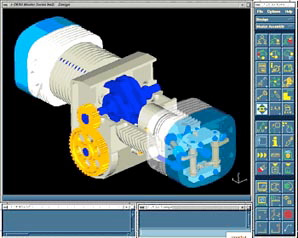Chapter 10: CAD/CAM/CADD/CAE
10.4 SDRC / Unigraphics
SDRC

In 1967, after leaving his teaching position at the University of Cincinnati’s mechanical engineering program, Jack Lemon established the Structural Dynamics Research Corporation (SDRC). “I established the company to help solve problems that plagued manufacturers,” said Lemon. “At the time, Computervision and Applicon were the software leaders, but they focused their efforts on the 2-D drafting marketplace. Our vision was to integrate design, FEA (Finite Element Analysis), testing, and systems to overall product design. We were among the first to integrate 2-D drafting with CAE. This effort prompted the need for solid modeling. This was the impetus behind Geomod, a product that provided capabilities to do FEA more efficiently to increase productivity.”
Later, while still with SDRC, Lemon’s development team introduced Superb FEA, Modal Plus, a modal testing analysis and analysis program, and SuperTAB, the first commercial modeling package that ran on DEC workstations. SDRC first brought their products to market in the early 1970’s. At that time, both Ford Motor Company and General Motors started using SDRC software for pre and post process analysis. SDRC first introduced their I-DEAS software in 1982. Developed by SDRC’s internal product development organization, I-DEAS was created to address the growing MCAE (Mechanical Computer-Aided Engineering) marketplace.
In 1993, after eleven years of continued growth, SDRC introduced the I-DEAS “Master Series.” This new generation of software products for mechanical design automation was completely reconfigured. Automotive manufacturers in particular used I-DEAS to design any automotive component or assemblies that were beneath the Class 1 surfaces of an automobile. The product also proved itself valuable for designing other aspects of automobiles, such as drive trains, engines, transmissions, chassis components (such as brakes and suspensions, etc.), and seats. In addition to the automotive/transportation industry, I-DEAS was also used in aerospace and defense, electronics and consumer products, industrial equipment, and energy and process. But the lion’s share of the users (and SDRC revenue) came from the automotive industry. In 2001 news was released that EDS intended to purchase all of the assets of SDRC. EDS wanted to build a new business unit around SDRC and their previous acquisition UGS, which continued to be known as UGS and operates as an EDS subsidiary.
Unigraphics
United Computing was founded by John Wright in Torrance, California. The first product released by United Computing was UNIAPT, which was a minicomputer based version of APT (Automatic Programmed Tool), a part programming language used to compute tool paths for milling machines. The unique thing about UNIAPT was that is was one of the first CAM products that was sold to the actual end users. Up until this time most companies created their NC programs using time-sharing services from large providers such as McAuto.
In 1973 United purchased the ADAM (Automated Design and Manufacturing) code from Hanratty’s MCS. United paid for exclusive rights to the software for both the U.S. and the rest of the world, except for Japan. (However, Hanratty also sold “exclusive” ADAM licenses to both Computervision and Gerber.) MCS updated the software, calling it AD-2000. Licenses for AD-2000 were sold to Autotrol, Graftek, and Control Data, among others.
In 1973 the ADAM software was ported to a General Automation SPC-16 (an early 16 bit mini-computer) with a Tektronix display and an added menu-driven user interface. This was implemented as a single-user system and given the name Uni-graphics (the hyphen was removed in 1974). In 1981, Unigraphics introduced the first solid modeling system, Uni-Solids. It was based on the University of Rochester’s PADL-2, and was sold as a stand-alone product to Unigraphics. It provided basic 2D modeling & drafting functionality and supported 14 layers. One of the selling points was that it was a graphical “front-end” for the UNIAPT system.
In 1976 United Computing was acquired by McDonnell Douglas. The company remained in Carson, California but was operated as a wholly owned subsidiary of St. Louis based McAuto, the Automation division of MDC. That same year the GRIP programming language was introduced. It was originally intended to address a request for support of parametric modeling. While it would be years before there were tools that adequately addressed this need, GRIP turned out to be one of the most popular and widely used modules ever offered with Unigraphics. For many years GRIP was considered by many customers to be the most significant differentiator between Unigraphics and the other CAD systems available.
After the problems with getting a stable version of Unigraphics released, McDonnell Douglas decided to close down United Computing and make formal financial arrangements with John Wright and the other founders. The remainder of the organization became part of the newly formed CAD/CAM division of McAuto.
In 1979 Unigraphics Solutions acquired Engineering Animation Inc. (EAI) of Ames, IA. EAI products included the line e-Vis and Vis-View software. EAI had been a longtime partner with Unigraphics Solutions, supplying tools used in Unigraphics’ ProductVision software.
In 1988 Unigraphics acquired Cambridge, England based Shape Data Ltd. (developers of Romulus, Romulus-D, and Parasolid) and began commercializing the Parasolid kernel as a stand-alone product. Parasolid was an extremely powerful B-rep solid modeling kernel that allowed the joining of boundary represented surfaces together as a solid. In 1999 Unigraphics Solutions Inc. announced that it had reached an agreement to purchase Applicon, Inc.

